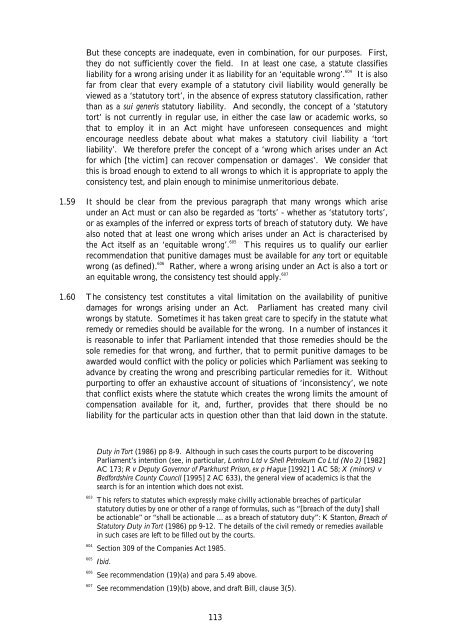Aggravated, Exemplary and Restitutionary ... - Law Commission
Aggravated, Exemplary and Restitutionary ... - Law Commission
Aggravated, Exemplary and Restitutionary ... - Law Commission
You also want an ePaper? Increase the reach of your titles
YUMPU automatically turns print PDFs into web optimized ePapers that Google loves.
But these concepts are inadequate, even in combination, for our purposes. First,<br />
they do not sufficiently cover the field. In at least one case, a statute classifies<br />
liability for a wrong arising under it as liability for an ‘equitable wrong’. 604<br />
It is also<br />
far from clear that every example of a statutory civil liability would generally be<br />
viewed as a ‘statutory tort’, in the absence of express statutory classification, rather<br />
than as a sui generis statutory liability. And secondly, the concept of a ‘statutory<br />
tort’ is not currently in regular use, in either the case law or academic works, so<br />
that to employ it in an Act might have unforeseen consequences <strong>and</strong> might<br />
encourage needless debate about what makes a statutory civil liability a ‘tort<br />
liability’. We therefore prefer the concept of a ‘wrong which arises under an Act<br />
for which [the victim] can recover compensation or damages’. We consider that<br />
this is broad enough to extend to all wrongs to which it is appropriate to apply the<br />
consistency test, <strong>and</strong> plain enough to minimise unmeritorious debate.<br />
1.59 It should be clear from the previous paragraph that many wrongs which arise<br />
under an Act must or can also be regarded as ‘torts’ - whether as ‘statutory torts’,<br />
or as examples of the inferred or express torts of breach of statutory duty. We have<br />
also noted that at least one wrong which arises under an Act is characterised by<br />
the Act itself as an ‘equitable wrong’. 605<br />
This requires us to qualify our earlier<br />
recommendation that punitive damages must be available for any tort or equitable<br />
wrong (as defined). 606<br />
Rather, where a wrong arising under an Act is also a tort or<br />
an equitable wrong, the consistency test should apply. 607<br />
1.60 The consistency test constitutes a vital limitation on the availability of punitive<br />
damages for wrongs arising under an Act. Parliament has created many civil<br />
wrongs by statute. Sometimes it has taken great care to specify in the statute what<br />
remedy or remedies should be available for the wrong. In a number of instances it<br />
is reasonable to infer that Parliament intended that those remedies should be the<br />
sole remedies for that wrong, <strong>and</strong> further, that to permit punitive damages to be<br />
awarded would conflict with the policy or policies which Parliament was seeking to<br />
advance by creating the wrong <strong>and</strong> prescribing particular remedies for it. Without<br />
purporting to offer an exhaustive account of situations of ‘inconsistency’, we note<br />
that conflict exists where the statute which creates the wrong limits the amount of<br />
compensation available for it, <strong>and</strong>, further, provides that there should be no<br />
liability for the particular acts in question other than that laid down in the statute.<br />
Duty in Tort (1986) pp 8-9. Although in such cases the courts purport to be discovering<br />
Parliament’s intention (see, in particular, Lonhro Ltd v Shell Petroleum Co Ltd (No 2) [1982]<br />
AC 173; R v Deputy Governor of Parkhurst Prison, ex p Hague [1992] 1 AC 58; X (minors) v<br />
Bedfordshire County Council [1995] 2 AC 633), the general view of academics is that the<br />
search is for an intention which does not exist.<br />
603 This refers to statutes which expressly make civilly actionable breaches of particular<br />
statutory duties by one or other of a range of formulas, such as “[breach of the duty] shall<br />
be actionable” or “shall be actionable ... as a breach of statutory duty”: K Stanton, Breach of<br />
Statutory Duty in Tort (1986) pp 9-12. The details of the civil remedy or remedies available<br />
in such cases are left to be filled out by the courts.<br />
604 Section 309 of the Companies Act 1985.<br />
605 Ibid.<br />
606 See recommendation (19)(a) <strong>and</strong> para 5.49 above.<br />
607 See recommendation (19)(b) above, <strong>and</strong> draft Bill, clause 3(5).<br />
113
















